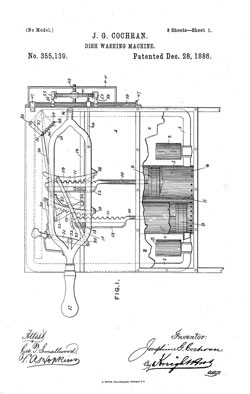 Josephine Cochran was issued Patent No. 355,139 on December 28,1886 for a dish washing machine. Cochran was a wealthy woman in Illinois who frequently hosted dinner parties. She became frustrated when her servants would chip or break her heirloom china so she began washing her own dishes. She was upset with the indignity of having to wash her own dishes and decided that there must be a better way. Since no one else had invented something, she was going to do it herself.
Josephine Cochran was issued Patent No. 355,139 on December 28,1886 for a dish washing machine. Cochran was a wealthy woman in Illinois who frequently hosted dinner parties. She became frustrated when her servants would chip or break her heirloom china so she began washing her own dishes. She was upset with the indignity of having to wash her own dishes and decided that there must be a better way. Since no one else had invented something, she was going to do it herself.
Cochran set to work on her design, staying home from a vacation with her ailing husband. She began by measuring the dishes. She then built wire compartments to fit either cups, plates or saucers. The compartments were placed on a wheel which was turned by a motor inside a watertight metal box. Hot soapy water squirted up in and rained down on the dishes cleaning them. Continue reading “Famous Women Inventors: Josephine Cochran – Dishwasher Patent”

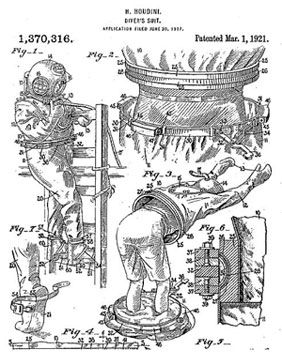 Harry Houdini was born in Budapest, Hungary, to a Jewish family. Houdini began his career as a trapeze artist and was later renowned as a magician and an escape artist. He astonished audiences by escaping from handcuffs, straitjackets, and prison cells.
Harry Houdini was born in Budapest, Hungary, to a Jewish family. Houdini began his career as a trapeze artist and was later renowned as a magician and an escape artist. He astonished audiences by escaping from handcuffs, straitjackets, and prison cells.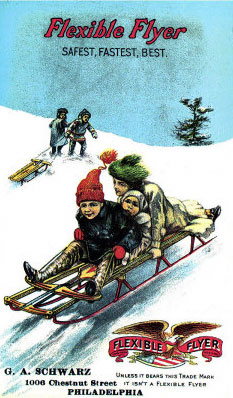 The Flexible Flyer was invented over 100 years ago by a farm equipment manufacturer. Looking to provide year round employment for his workers, Samuel Leeds Allen began trying to invent a sled in the 1880’s. Coasting, as sledding was then known, was very popular and Allen was hoping to capitalize on this.
The Flexible Flyer was invented over 100 years ago by a farm equipment manufacturer. Looking to provide year round employment for his workers, Samuel Leeds Allen began trying to invent a sled in the 1880’s. Coasting, as sledding was then known, was very popular and Allen was hoping to capitalize on this.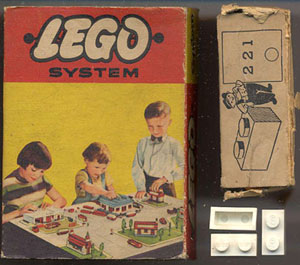 On January 28, 1958 at 1:58 pm Godtfred Kirk Christiansen submitted the patent application for the improved Lego brick and building system in Copenhagen, Denmark. Today, the thousands of different shapes, sizes and colors of Legos are all designed to connect with the original brick from the Danish patent. All 2×4 Legos made since 1958 have been manufactured to the exact same measurements as the version outlined in the original patent.
On January 28, 1958 at 1:58 pm Godtfred Kirk Christiansen submitted the patent application for the improved Lego brick and building system in Copenhagen, Denmark. Today, the thousands of different shapes, sizes and colors of Legos are all designed to connect with the original brick from the Danish patent. All 2×4 Legos made since 1958 have been manufactured to the exact same measurements as the version outlined in the original patent.
 The first US patent for PEZ, #2,620,061, was issued December 2, 1952 for a Pocket Article Dispensing Container. This patent was for the original design of the PEZ dispenser which was meant to look like a cigarette lighter.
The first US patent for PEZ, #2,620,061, was issued December 2, 1952 for a Pocket Article Dispensing Container. This patent was for the original design of the PEZ dispenser which was meant to look like a cigarette lighter.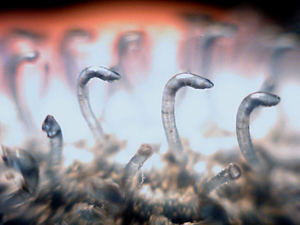 The idea for Velcro came to George de Mestral, a Swiss engineer, after returning from a walk in the Alps with his dogs. He examined the burrs stuck to both his jacket and the dogs’ fur under a microscope. The principal, he discovered, was simple. The burr was made of hundreds of hooks that would catch on anything with a loop such as cloth, animal fur or hair. De Mestral saw that this design could be used as a new type of fastener if he could duplicate the hooks and loops.
The idea for Velcro came to George de Mestral, a Swiss engineer, after returning from a walk in the Alps with his dogs. He examined the burrs stuck to both his jacket and the dogs’ fur under a microscope. The principal, he discovered, was simple. The burr was made of hundreds of hooks that would catch on anything with a loop such as cloth, animal fur or hair. De Mestral saw that this design could be used as a new type of fastener if he could duplicate the hooks and loops.